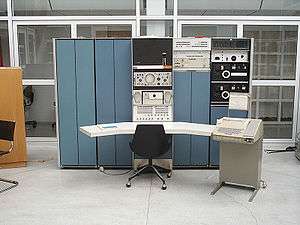PDP-7
|
A modified PDP-7 under restoration in Oslo, Norway | |
| Manufacturer | Digital Equipment Corporation |
|---|---|
| Type | minicomputer |
| Release date | 1965 |
| Introductory price | US$72,000 (equivalent to $541,559 in 2015) |
| Units sold | 120[1][2] |
| Units shipped | 120[2] |
| Memory | 4K words (9 kB) (expandable up to 64K words (144 kB).)[1] |
| Storage | paper-tape and dual transport DECtape drives (type 555) |
| Display | printer |
| Input | keyboard |
| Predecessor | PDP-4 |

The DEC PDP-7 was a minicomputer produced by Digital Equipment Corporation as part of the PDP series. Introduced in 1965, it was the first to use their Flip-Chip technology. With a cost of only US$72,000, it was cheap but powerful by the standards of the time. The PDP-7 was the third of Digital's 18-bit machines, with essentially the same instruction set architecture as the PDP-4 and the PDP-9. It was the first wire-wrapped PDP. The computer had a memory cycle time of 1.75 µs and add time of 4 µs. I/O included a keyboard, printer, paper-tape and dual transport DECtape drives (type 555).[3] The standard memory capacity was 4K words (9 kB) but expandable up to 64K words (144 kB).[1]
In 1969, Ken Thompson wrote the first UNIX system in assembly language on a PDP-7,[4] then named Unics as a pun on Multics, as the operating system for Space Travel, a game which required graphics to depict the motion of the planets. A PDP-7 was also the development system used during the development of MUMPS at MGH in Boston a few years earlier.
There are few remaining PDP-7 systems still in operable condition. A PDP-7A (S#115) was under restoration in Oslo, Norway,[5] a second PDP-7A (S#113) previously located at the University of Oregon in its Nuclear Physics laboratory is now at the Living Computer Museum in Seattle, Washington and is almost completely restored to running condition after being disassembled for transport.[6] Another machine, a PDP-7 (S#47) is known to be in the collection of Max Burnet near Sydney, Australia, and a fourth PDP-7 machine (S#33) is in storage at the Computer History Museum in Mountain View, California.
References
- 1 2 3 The PDP-7 was used by Thompson for first version of UNIX, 2007-09-27, The Linux Information Project, linfo.org
- 1 2 PDP-7 entry from Year 1964 in the DIGITAL Computing Timeline, Ultimately, 120 PDP-7s were produced and sold.
- ↑ reference.com - Pdp-7 | Define Pdp-7 at Dictionary.com, accessed 2012-12-25
- ↑ Dennis M. Ritchie."The Development of the C Language".
- ↑ "Archived copy". Archived from the original on July 15, 2012. Retrieved June 24, 2005. PDP-7 restoration project located in Oslo, Norway.
- ↑ "Archived copy". Archived from the original on March 14, 2012. Retrieved March 2, 2011. University of Oregon's PDP-7 moves to the Living Computer Museum in Seattle, Washington. Alternate host at http://www.soemtron.org/pdp7no113systeminfo.html "January 2011" section.
External links
| Wikimedia Commons has media related to Programmed Data Processor. |
- Information about the PDP-7 and PDP-7/A, including some manuals and a customer list covering 99 of the possible 120 systems shipped, Digital Equipment Corporation PDP-7.
- Raymond, Eric Steven (2003-09-19). "Origins and History of Unix, 1969–1995". faqs.org. Retrieved 2008-07-13.
- "The famous PDP-7 comes to the rescue" (Bell Labs' Unix history) at the Wayback Machine (archived April 2, 2014)
